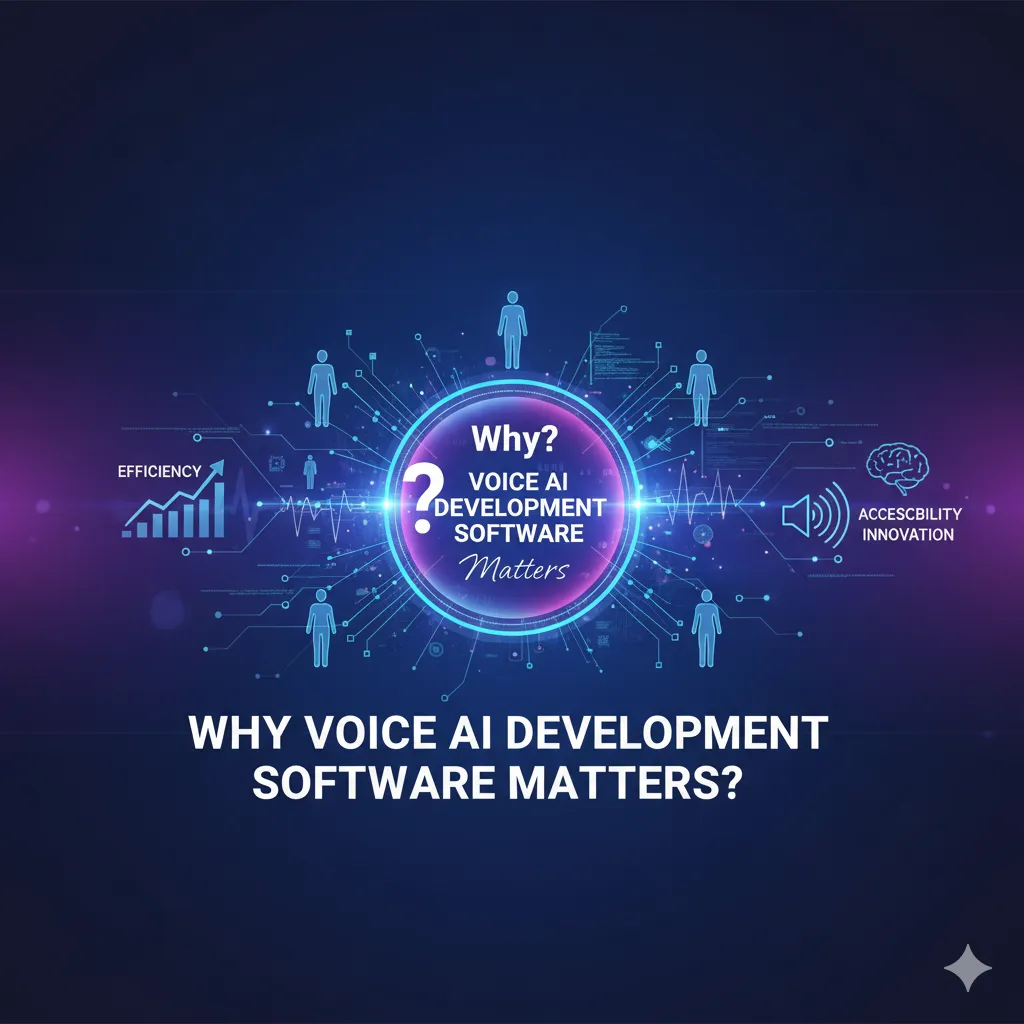
Why Voice AI Development Software Matters?

Voice AI development software is the platform and toolset teams use to design, train, deploy, and observe conversational voice agents that handle speech recognition, language understanding, and natural-sounding responses. These systems combine ASR (automatic speech recognition), NLU (natural language understanding), NLG (natural language generation), and TTS (text-to-speech) to turn spoken interactions into business actions that capture leads faster, cut response times, and boost operational efficiency. In this piece we unpack the technical building blocks of advanced voice AI, show how those capabilities drive measurable outcomes like lead generation and customer engagement, and explain why Responsible AI is a must for enterprise adoption. You’ll get a checklist of features to evaluate, emerging trends such as neural prosody modeling, and real-world patterns that prove impact — plus practical design and deployment guidance for teams launching voice AI initiatives.
Which Core Features Define Advanced Voice AI Development Software?
Top-tier voice AI platforms focus on precise language understanding, natural reply generation, expressive speech synthesis, and solid integrations that tie conversations to business workflows. These capabilities live in modular components — NLU and NLG for intent and response, TTS and prosody for natural voice, APIs and webhooks for data flow, and analytics for outcomes — that together lower friction in voice experiences and lift conversion rates. Below are the key capabilities buyers should prioritize and the practical benefits each delivers for customer-facing systems.
Natural Language Understanding (NLU): Identifies intent and extracts entities for accurate, context-aware routing.
Natural Language Generation (NLG): Crafts coherent, context-sensitive replies that keep conversations moving.
Neural TTS and Prosody Modeling: Produces voices with realistic intonation, pacing, and emphasis.
Emotional Intelligence and Sentiment Detection: Senses mood and adapts tone or escalation paths accordingly.
Multilingual Support: Supports multiple languages and dialects to serve diverse customer bases.
Integration APIs and Webhooks: Connects voice interactions to CRM, ticketing, and analytics so actions follow conversation.
Analytics and Reporting Modules: Tracks conversion, deflection, and SLA metrics to quantify ROI.
These components form the practical anatomy of a conversational AI stack and enable cross-functional wins like higher lead conversion, shorter handle times, and better customer satisfaction. Knowing how each piece maps to KPIs helps teams prioritize investment and choose vendors.
How Do Natural Language Understanding and Generation Boost Voice AI Performance?

Natural Language Understanding (NLU) decodes spoken input — it detects intent and pulls out entities — while Natural Language Generation (NLG) composes responses that fit the user’s context. Paired together, they reduce misunderstandings, cut error rates, and support multi-turn dialogs that keep context across exchanges, which improves completion and conversion rates. A typical intent pipeline: detect intent → extract entities → resolve context → apply decision logic → trigger NLG for a tailored reply. Add validation layers and confidence thresholds and you can route low-confidence cases to humans, preserving quality while keeping automation. The outcome is measurable: higher accuracy, faster resolutions, and better user satisfaction — the baseline for high-performing voice deployments.
Why Do Emotional Intelligence and Contextual Awareness Matter for Voice AI?
Emotional intelligence and context retention let voice agents sense sentiment, adjust responses, and keep multi-turn context so conversations feel coherent and human. Sentiment models and prosody analysis spot frustration, urgency, or calmness and can trigger escalation, tailored offers, or a softer dialog style — protecting brand reputation and increasing conversions. Retaining context across a session avoids repeated questions, shortens resolution times, and elevates perceived competence. Typical architectures combine short-term context windows, session state, and profile enrichment to balance responsiveness with privacy. When implemented well, these capabilities build trust and drive engagement — which is how voice interactions become leads and revenue.
How Does Voice AI Drive Growth Through Lead Generation and Engagement?
Voice AI grows pipeline by turning spoken interactions into qualified leads, automating core qualification steps, and answering instantly so opportunities aren’t lost. The model combines 24/7 availability, guided qualification dialogs, and integration with marketing and sales funnels so interactions are captured and routed into the right follow-up workflows. When voice bots use personalized prompts, context-aware suggestions, and automated scheduling or data capture, they shorten time-to-contact and increase qualified leads entering CRM. Below is a common workflow and the conversion mechanics teams should design for measurable outcomes.
Immediate Greeting and Intent Capture: Welcome the caller and detect reason for contact to begin qualification right away.
Automated Qualification Questions: Collect key lead attributes with dynamic dialogs and score leads using rules or ML.
Routing and Scheduling: Send qualified leads to sales queues or schedule callbacks to preserve intent.
Follow-up Orchestration: Trigger email/SMS or create tasks in downstream systems to keep nurture moving.
These steps show how conversational flows become pipeline actions.
How Do AI Voice Bots Improve Lead Generation Efficiency?
AI voice bots streamline lead generation by running structured qualification scripts and ML-driven scoring that surface high-value prospects and filter low-fit contacts. Real-time entity extraction captures the details sales need — budget, timeline, product interest — without manual entry, and webhooks or APIs push that data into CRMs immediately to prevent lead leakage. Automating first-touch delivers consistent qualification across time zones and peak volumes that would otherwise overwhelm human teams. Faster qualification lowers time-to-contact so sales engages while intent is high, raising conversion rates and shortening sales cycles.
How Does Voice AI Improve Engagement and Operational Efficiency?
Voice AI raises engagement by delivering a consistent brand voice, instant answers, and personalized interactions that honor user context and history — boosting satisfaction and loyalty. Operationally, voice automation deflects routine questions (status checks, FAQs, simple transactions), freeing agents to handle complex issues and lowering average handle time and cost-per-contact. Session analytics reveal process bottlenecks and training gaps, enabling continuous dialog improvement and smarter workforce planning. Those gains translate to better SLA compliance and higher CSAT, and they underscore why Responsible AI governance matters when automating customer channels.
What is responsible deployment of AI?

Responsible AI is an approach to developing and deploying artificial intelligence from both an ethical and legal standpoint. The goal is to employ AI in a safe, trustworthy and ethical way. Using AI responsibly should increase transparency while helping to reduce issues such as AI bias. Responsible AI makes sure voice bots behave ethically, transparently, and securely — with human oversight for sensitive decisions. Explainability, bias mitigation, privacy, and accountability are essential because voice interactions often carry personal data and can trigger outcomes that affect customers. Putting Responsible AI into practice means adding consent flows and logging, running bias tests on language models, and enabling human-in-the-loop escalation for high-stakes cases. These controls cut legal and reputational risk and make it easier for enterprises to scale voice AI across regulated domains.
Transparency and Consent: Notify users they’re talking to an AI and capture consent for data use.
Fairness and Bias Testing: Regular checks to find and reduce disparities in recognition or treatment.
Accountability and Governance: Clear ownership, audit trails, and escalation paths for errors or disputes.
Privacy and Security Controls: Encryption, anonymization, and retention policies for audio and transcripts.
Building these principles into the development lifecycle increases trust and compliance.
What Do Responsible AI Principles Look Like in Practice for Voice AI?
Responsible AI principles — transparency, fairness, accountability, and privacy — become concrete controls like disclosure prompts, bias audits, role-based access, and data-minimization policies that protect users and the organization. For example, log transcripts and model decisions with metadata so auditors can reconstruct outcomes; run bias tests on representative voice samples to find issues across accents and languages; and set governance that assigns owners for model updates, monitors performance drift, and requires human sign-off for high-impact automations. These measures produce safer deployments that regulators and customers accept more readily and form the basis for secure voice operations described next.
How Does Responsible AI Strengthen Security and Transparency?
Responsible AI strengthens security and transparency by defining technical safeguards — encryption of audio in transit and at rest, role-based transcript access, and immutable audit logs — that prevent misuse and enable traceability. Exposing confidence scores and concise rationale for decisions helps operators know when to intervene and lets customers understand outcomes. Combine those practices with privacy-preserving data handling and explicit consent flows and you reduce regulatory exposure while building trust. These protections also make integrations with CRM and analytics systems safer, which we cover in the following section.
How Can Voice AI Development Software Integrate Seamlessly with Existing Systems?
Seamless integration relies on an API-first architecture, event-driven webhooks, and pre-built connectors for common enterprise endpoints like CRM, ticketing, analytics, and telephony. Typical patterns include synchronous API lookups, asynchronous events for post-call processing, and middleware for schema translation and orchestration. Data mapping should preserve intent, confidence scores, and key extracted entities so downstream systems can act without ambiguity. Below are common integration endpoints and recommended patterns for reliable data flow and interoperability.
CRM Connectors: Push leads, update records, and attach transcripts for context.
Ticketing Systems: Create or update tickets with resolution status and voice notes.
Analytics Pipelines: Stream session metrics and sentiment to BI tools for trend analysis.
Telephony Gateways: Bridge PSTN or SIP infrastructure to cloud voice engines via secure SIP connectors.
Mapping these integration points to capabilities helps teams plan pilots and data contracts.
Which Integration Capabilities Support CRM and Enterprise Connectivity?
Integration capabilities include pre-built connectors for common CRMs and ticketing systems, custom API adapters for proprietary platforms, and middleware that normalizes data and handles retries. Pre-built connectors speed time-to-value for standard fields (name, phone, intent, confidence), while custom adapters let teams map domain-specific attributes and enforce business rules. Event-driven architectures with webhooks and queues enable near-real-time sync and resilience to outages. Security controls like OAuth, tokenized credentials, and encrypted payloads protect sensitive fields and ensure audit trails record provenance for every lead or ticket.
How Do Scalability and Customization Help Voice AI Grow with the Business?
Scalability and customization come from cloud-native architectures, auto-scaling voice engines, multi-tenant orchestration, and feature toggles that let teams roll out dialogs and personas progressively. Auto-scaling handles concurrency spikes without performance loss; modular dialog components let teams reuse and tune language across verticals. Custom layers — admin consoles for dialog edits, persona tuning to match brand voice, and domain-specific NLUs — let organizations tailor experiences while keeping observability and governance intact. Observability that surfaces metrics, logs, and session traces makes growth predictable and speeds iteration on conversation models.
What Are the Latest Trends and Advances in Voice AI?
Recent advances include neural TTS with finer prosody control, larger multimodal models that improve context, and democratized APIs that cut build time for voice features. These innovations make voices sound more human, enable cross-modal reasoning between text and audio, and allow teams to prototype voice interactions without assembling a full stack. Market signals through 2024–2025 show growing investment and enterprise adoption focused on ROI use cases like lead generation and support automation. Developers now have tooling that shortens the path from prototype to production. The next section explains how neural TTS pipelines create natural-sounding voices and the trade-offs teams should consider.
Neural Prosody Modeling: Controls intonation, rhythm, and emphasis for expressive speech.
Multimodal Contextual Models: Combine text, audio, and metadata to improve understanding.
API Democratization: Lowers technical barriers so product teams ship voice features faster.
Accessibility and Localization Tools: Better language models and localized TTS for broader inclusion.
How Are Natural-Sounding AI Voices Built with Neural Networks and Prosody Modeling?
Natural-sounding AI voices come from multi-stage neural pipelines: a text frontend, an acoustic model, and a vocoder, enhanced by prosody controllers that shape pitch, duration, and emphasis. The acoustic model predicts spectral features from text and prosody inputs; the vocoder turns those into waveform audio with realistic timbre. Prosody controls give designers knobs for intonation, stress, and tempo so you can match brand persona or emotional tone without retraining the whole model. Ethical safeguards — consent for cloning, watermarking synthetic audio, and usage policies to prevent impersonation — help balance naturalness with responsibility.
What Market Trends and Adoption Signals Show Voice AI’s Growth?
Research and industry reports point to rising enterprise interest in voice AI driven by ROI-focused cases like lead capture, customer service automation, and operational savings. Funding and consolidation trends show vendors building broader conversational and analytics stacks. Adoption is strongest where immediate responses and high call volumes matter — sales, support, operations — driving standard integration and governance patterns. These signals suggest organizations that run measured pilots with clear KPIs will capture disproportionate value from voice automation.
How Do Real-World Deployments Show Voice AI’s Impact?
Real-world deployments demonstrate measurable gains in lead capture, faster responses, and revenue protection by handling peak volumes and preventing missed opportunities with 24/7 coverage. Case studies commonly report higher lead throughput, faster contact times, and fewer abandoned calls when voice bots run first-touch qualification and routing. For teams that need reliable, ethical automation, aligning deployments with Responsible AI practices reduces risk while preserving scale benefits. The section below summarizes client outcomes achieved with The Power Labs’ AI Voice Bot.
What Outcomes Have Clients Realized with The Power Labs AI Voice Bot?
Clients using The Power Labs AI Voice Bot report tangible improvements in lead handling and customer responsiveness. The Voice Bot is part of a coordinated Four-Bot AI System — alongside an AI Lead Gen Bot, AI Chat Bot, and AI Smart Operations Bot — designed to accelerate lead generation and business transformation instead of delivering isolated point tools. Deployments focus on 24/7 instant responses to prevent lost revenue and support end-to-end workflows, all built with Responsible AI principles to ensure transparent, fair, and secure interactions with human oversight. These outcomes show how integrated bot orchestration and governance create business value while maintaining compliance.
How Does Voice AI Support Multilingual and Accessible Interactions?
Voice AI enables multilingual and accessible interactions using ASR/TTS stacks tuned for multiple languages and dialects, localized dialog flows, and accessibility features such as simplified prompts and alternate channels for people with hearing or speech differences. Localization involves translating prompts, adapting cultural references, and testing voice personas in target markets to keep conversations natural. Accessibility features — captioning, transcripts, and simplified navigation — improve inclusion and help meet regulatory or corporate commitments. Thorough localization and accessibility testing during pilots increases adoption and delivers better customer outcomes.
Select Pilot Use Cases: Start with high-volume, high-value flows for initial automation.
Instrument Metrics Up Front: Define lead, conversion, and response-time KPIs before you deploy.
Implement Responsible AI Controls: Add consent, logging, and human escalation from day one.
These practical steps help teams convert technical capabilities into measurable business outcomes and prepare organizations to scale voice AI responsibly.
Frequently Asked Questions
Which industries benefit most from voice AI?
Voice AI delivers value across retail, healthcare, finance, and telecom — anywhere real-time voice interactions matter. Retail uses it for personalized customer service; healthcare for patient engagement and scheduling; finance for secure customer inquiries; and telecom for troubleshooting and support. Each sector sees reduced friction, faster responses, and improved operational efficiency.
How does voice AI protect data privacy and security?
Voice AI platforms protect privacy with encryption in transit and at rest, anonymization where appropriate, and data retention policies that meet regulations like GDPR. Responsible practices include capturing user consent, logging interactions for auditability, and applying access controls so sensitive data is only available to authorized systems and people.
What are common challenges when implementing voice AI?
Common challenges include integrating with legacy systems, achieving high ASR accuracy across accents and dialects, and aligning user expectations. Deployments also require privacy and compliance planning and continuous monitoring to address drift. Iterative testing and clear operational playbooks are critical to overcoming these hurdles.
How should businesses measure success for voice AI initiatives?
Measure success with KPIs like lead conversion rates, customer satisfaction (CSAT), average handling time, and automation rate. Track response accuracy, engagement, and the volume of automated interactions to understand effectiveness. Use these metrics to refine dialogs and operational handoffs.
How important is user feedback in voice AI development?
User feedback is essential. It highlights accuracy issues, conversational friction, and usability gaps so teams can refine models and dialog flows. Continuous feedback loops ensure the system evolves to meet real user needs and improves engagement over time.
Can voice AI be customized for specific business needs?
Absolutely. Voice AI is highly customizable: dialog flows, integration logic, tone and persona, and industry-specific language can all be tailored. Training models on domain terminology and real conversation data ensures the system meets each business’s unique requirements.
What future trends should businesses expect in voice AI?
Look for better emotional intelligence, deeper multimodal context (text + audio + metadata), wider localization, and more accessible tooling that speeds delivery. Expect continued emphasis on Responsible AI, improved prosody control, and stronger integrations that let voice become a standard channel in customer engagement stacks.
Conclusion
Voice AI development software can transform how organizations capture leads, engage customers, and run operations. With capabilities like NLU, emotional intelligence, and neural TTS, businesses can create conversations that feel natural and drive measurable results. If you’re considering voice automation, start with a focused pilot, instrument KPIs, and bake Responsible AI into your plan. Explore our offerings to see how a tailored voice AI solution can elevate your customer interactions and protect revenue.